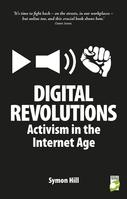 This book transcends glib positions about the internet and social movements (eg ‘social media cause revolution’ or ‘the internet should be discounted altogether in resistance’) to offer a rich and considered analysis, backed up by engaging case studies from a range of issues, communities and continents.
This book transcends glib positions about the internet and social movements (eg ‘social media cause revolution’ or ‘the internet should be discounted altogether in resistance’) to offer a rich and considered analysis, backed up by engaging case studies from a range of issues, communities and continents.
Hill doesn’t downplay the net’s influence, noting that social media sites such as YouTube have made it easier ‘to see the truth that the powerful would rather hide’, affecting the forms that resistance takes and making it easier for people to exchange ideas and strategies. In the case of the Uncut or Slutwalk movements for example, this has happened through the inclusion on Twitter of the symbol ‘#’ (the ‘hashtag’).
Moreover, social media are also a challenge to hierarchical organisation, reducing reliance on centralised leadership.
Ultimately, the book suggests, the internet is just another tool, albeit a hugely useful one: ‘Facebook and Twitter did not overthrow Ben Ali or Mubarak, any more than the printing press overthrew Charles I’. And this, for me, is what makes Digital Revolutions particularly relevant to grassroots activists: it recognises that this tool has its uses, while remembering that movements arise in response to economic and social dynamics, not to changes in modes of communication.
Similarly, the book explores how the power of social movements is not based on whether or not they get a lot of ‘likes’ on Facebook. The potential for change takes off when people physically come together.
Indeed, the prominent Egyptian internet activist Wael Ghonim notes that the ‘final phase’ of the campaign against Mubarak only occurred ‘when people decided to take the action [off the internet and] onto the street.’ Many examples are provided.
This narrative of action, both virtual and real, is a threat to the small minority ‘who control the tanks and the money’, and Digital Revolutions also looks at the response by governments and corporations. It is also upfront about the net’s limitations, eg issues of exclusion.
All in all, a timely, informative overview of campaigns and social movements that continue to evolve — and of a tool that will inevitably continue to change too.


